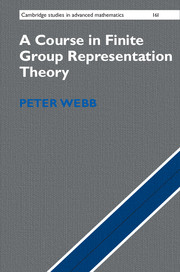Book contents
- Frontmatter
- Contents
- Preface
- 1 Representations, Maschke's Theorem, and Semisimplicity
- 2 The Structure of Algebras for Which Every Module Is Semisimple 15
- 3 Characters
- 4 The Construction of Modules and Characters
- 5 More on Induction and Restriction: Theorems of Mackey and Clifford
- 6 Representations of p-Groups in Characteristic p and the Radical
- 7 Projective Modules for Finite-Dimensional Algebras
- 8 Projective Modules for Group Algebras
- 9 Changing the Ground Ring: Splitting Fields and the Decomposition Map
- 10 Brauer Characters
- 11 Indecomposable Modules
- 12 Blocks
- Appendix A Discrete Valuation Rings
- Appendix B Character Tables
- Bibliography
- Index
3 - Characters
Published online by Cambridge University Press: 05 August 2016
- Frontmatter
- Contents
- Preface
- 1 Representations, Maschke's Theorem, and Semisimplicity
- 2 The Structure of Algebras for Which Every Module Is Semisimple 15
- 3 Characters
- 4 The Construction of Modules and Characters
- 5 More on Induction and Restriction: Theorems of Mackey and Clifford
- 6 Representations of p-Groups in Characteristic p and the Radical
- 7 Projective Modules for Finite-Dimensional Algebras
- 8 Projective Modules for Group Algebras
- 9 Changing the Ground Ring: Splitting Fields and the Decomposition Map
- 10 Brauer Characters
- 11 Indecomposable Modules
- 12 Blocks
- Appendix A Discrete Valuation Rings
- Appendix B Character Tables
- Bibliography
- Index
Summary
Characters are an extremely important tool for handling the simple representations of a group. In this chapter, we will see them in the form that applies to representations over a field of characteristic zero, and these are called ordinary characters. Since representations of finite groups in characteristic zero are semisimple, knowing about the simple representations in some sense tells us about all representations. Later, in Chapter 10, we will study characters associated to representations in positive characteristic, the so-called Brauer characters.
Characters are very useful when we have some specific representation and wish to compute its decomposition as a direct sum of simple representations. The information we need to do this is contained in the character table of the group, which we introduce in this chapter. We also establish many important theoretical properties of characters that enable us to calculate them more easily and to check that our calculations are correct. The most spectacular of these properties is the orthogonality relations,which may serve to convince the reader that something extraordinary and fundamental is being studied. We establish numerical properties of the character degrees, and a description of the center of the group algebra that aids in decomposition the group algebra as a sum of matrix algebras. This would be of little significance unless we could use characters to prove something outside their own area. Aside from their use as a computational tool, we use them to prove Burnside's paqb theorem: every group whose order is divisible by only two primes is solvable.
The Character Table
Assume that ρ : G → GL(V) is a finite-dimensional representation of G over the field of complex numbers C or one of its subfields.We define the character χ of ρ to be the function χ : G → C given by
the trace of the linear map ρ(g). The degree of the character is dimV, which equals χ(1). For example, the 2-dimensional representation of S3 we considered in Chapter 1 has character given on the group elements by forming the representing matrices and taking the trace as follows:
We say that the representation ρ and the representation space V afford the character χ, and we may write χρ or χV when we wish to specify this character more precisely.
- Type
- Chapter
- Information
- A Course in Finite Group Representation Theory , pp. 24 - 55Publisher: Cambridge University PressPrint publication year: 2016

